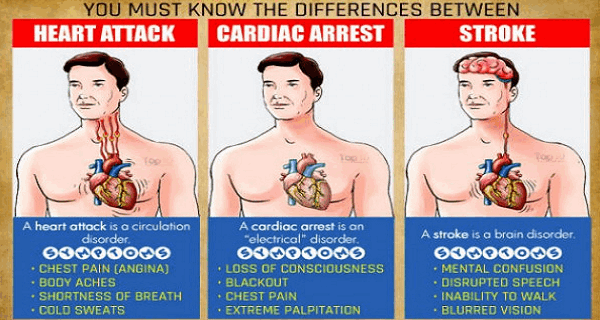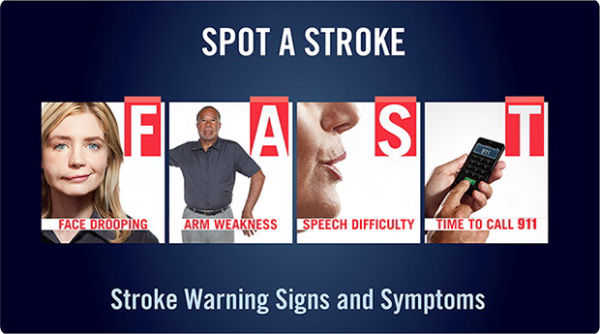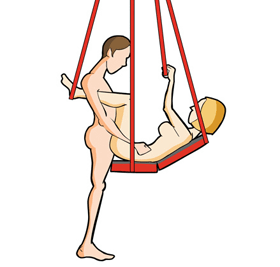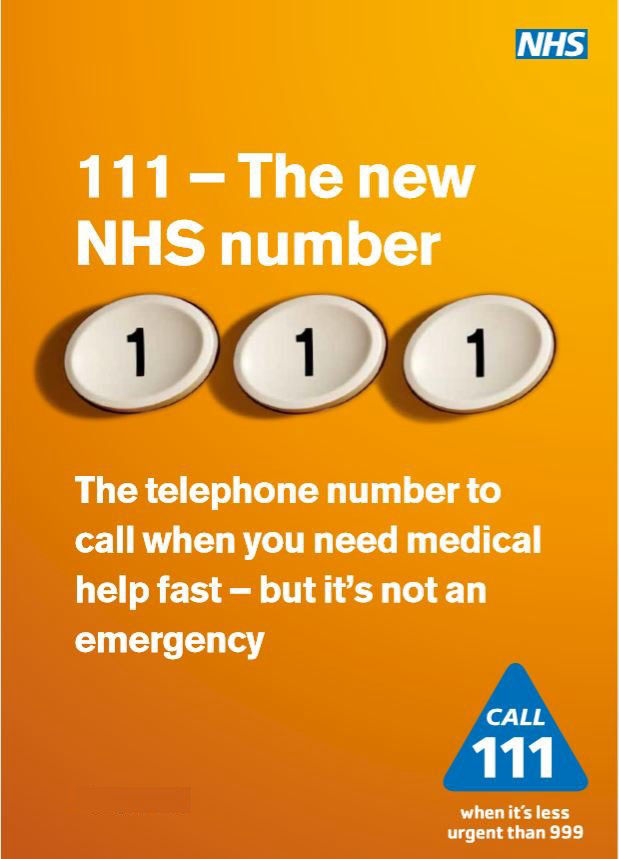THESE PAGES ARE FOR INFORMATION ONLY
ALWAYS DIAL 999 AND REQUEST QUALIFIED MEDICAL ASSISTANCE
It can be hard for those without first-aid or medical training to spot a stroke or distinguish between a heart attack.

Learn which signs indicate a stroke

Do the fast test
The symptoms associated with TIA's or Minor Strokes are the same as for Major Strokes, but they may only last for a few minutes. They include any one or a combination of the following effects: Sudden numbness or a weakness in the face, arms or legs, especially on one side of the body, along with sudden trouble in speaking or understanding
The most common form of stroke. Caused by a clot causing the narrowing or blocking of blood vessels preventing blood from reaching particular areas of the Brain. This leads to the brain cells dying due to lack of oxygen.
This type of stroke occurs when a weakened blood vessel in the brain bursts causing the vessel to bleed into the brain and cause damage
These are similar to the previous strokes and have the same signs, but usually improve and get better over a 24 hour period. But these can often be a warning sign of an impending more serious stroke and it is vital to receive the same F.A.S.T. action.
Credit to: HealthSketch
STROKES AND TIA's CAN HAPPEN TO ALL AGES
DO
Sit them down and make the person comfortable.
Immediately Dial 999
Re-assure and ensure complete rest until the Ambulance arrives.
Keep warm but make sure they do not overheat.
Stay with them.
If someone else with you, pack them a small overnight bag including
Medications. Pyjamas; Underwear; Slippers; Washing kit and clothes to return home with.
DO NOT
Leave alone.
Give them any drinks or food as swallowing may prove difficult and increase risk of choking.
Keep asking them questions, they may have difficulty speaking and the frustration of not being understood will increase stress and anxiety levels further.
Below are videos and information on how to help someone who is having a stroke.
Remember the first 3 letters of the word Stroke.
S - Smile Ask them to Smile
T - Talk Ask them to Talk
R - Raise Ask them to Raise both arms and hold them up
Another way to spot a stroke is to ask them to stick out tongue. Look to see if it hangs to one side or looks crooked.
F.A.S.T
Replacing the word Smile with Facial Weakness, as sometimes the patient is able to smile when asked. Signs of Facial weakness can be a droopy or twitching eyelid; turned down corner of mouth; numbness or pins and needles; crooked tongue or even dribbling from one side of mouth.
My Personal Story
As an ex-ambulanceman of many years, and someone who had dealt with many stroke victims, you would think I would have instantly noticed the signs and symptoms of a stroke.
NO!
Like most people I wasn't expecting myself to have a stroke, I was healthy, I definitely didn't want one, and like many I ignored some tell-tale signs.
As with many who have worked in the medical field, ambulance staff, nurses, even doctors, you avoid or ignore whats happening to you, and try to give things a simple explanation that minimises the gravity of any illness or situation, enabling you to continue what you are doing.
I had 3 or 4 mini-strokes and did not realise until told so a long time later!
I was working in residential care of abused children who had severe challenging behaviour, it had been a stressful day with continuous confrontation, aggression and even violence shown towards us, and at last things had quietened down, so I laid on the bed in the staff bedroom and prepared to try to sleep. Suddenly my head and body began to tingle, I felt totally paralysed and unable to move my arms and legs, my eyesight blurred and my scalp felt like a thousand pins were sticking into it. Then even more frightening I realised I was not automatically breathing, it was if my body had forgotten how, I had to consciously force myself top breathe, trying to gasp at air. I was unable to move, and unable to call out for help from another member of staff in the adjoining room, it was terrifying!
It lasted around 40 minutes, and gradually my body relaxed and although sweating profusely and still feeling panicked, my limbs regained movement. The tingling in my head remained for about an hour after, but at least I could now breathe. I put it down to tiredness and stress, after all I had been awake for two days and nights, and knowing I was going home in the morning I tried to rest.
About a month later I was at home and sitting at my computer, and suddenly I had the same tingling sensation, two of my arms and one leg became numb, and the text on my screen appeared to dance around. Again my breathing felt laboured, I was unable to continue typing or using a microphone, and I feared falling out of my chair. It lasted around 25 minutes, and yet again I put it all down to being extremely tired and stressed out from work.
A few weeks later it happened yet again, this time it only seemed to affect my upper body, my legs appeared to be okay, but again my arms felt as if I had been laying on them and they had gone to sleep, My scalp tingled and felt tender, and my vision was a little blurry. This time it was shorter, 10 - 15 minutes at the most, again it had been a stressful day, and followed a few days of poor sleep, and I shrugged it off as 'Just being tired'.
It was about a month after this before anything else happened, This time I was in the kitchen making dinner, when I felt a twinge at the back of my head where the spine meets the skull. Within a few seconds my head began to tingle with the needles and pins feeling, and I lost use of my left arm which now felt heavy and hung down. My breathing became erratic, and panic-mode set in. I was also boiling over, as if my body and brain was no longer able to regulate my temperature, I dripped sweat and was so dizzy I had to sit in front of an electric fan to try to cool down. The numbness of my arm lasted and my breathing settled after about 15 minutes, but the sweating and tingling continued for about an hour. We had been on a long country walk that day, I had not eaten, I had only managed a few hours sleep the night before, so once again things were ignored and put to the back of my mind.
Now it turns out that the stress I had recently been under, along with the accumulated stress of previous jobs going back many years, and the stress and anxiety of marital issues had triggered P.T.S.D. The effects on me that this caused disguised what was really going on, and these little 'episodes' were now assigned to the PTSD. I was forced to stop working due to these effects, which in turn also added to the stress further with finance worries, housing issues etc.
It wasn't to a few months later that I had what was recognised as a proper stroke. Well luckily for me it was not a full stroke, it was a TIA, generally considered as a 'Warning' or a 'mini-stroke'. It may not have been the full-blown stroke that we tend to know about, but it still required hospitalisation, and life changes.
When my first TIA happened I was still totally unaware, I had got up as normal, made a coffee, washed my face etc., then had started up my computer. I began typing on Skype to both my daughter and to a old friend of mine (ex work colleague). To my daughter I appeared to be typing as normal, yet to my friend it was different, as she put it 'it was like a monkey was hammering at the keyboard'. To me what I could see on screen seemed to make perfect sense, what appeared on her screen was just pure gibberish. She immediately guessed something was not right and telephoned me, and it only toook her a few seconds to realise I needed help. She messaged my daughter and made her contact my GP.
It was only after my second TIA and stay in hospital, and after examination, further testing and lengthy discussion with the stroke specialist, that my previous 'episodes' that had now conveniently been put down to PTSD, were revealed as being previous TIA's or minor strokes.
Through medication, and purposely changing my lifestyle to try to reduce stress or confrontation, it seemed to keep further TIA's or the more worrying 'Full Stroke' at bay. Not that there were not additional smaller episodes, I was sitting with my grandson when suddenly my whole body went into convulsions, not drastic flailing about, more like I had touched a live electric wire. My teeth chattered together, and my body vibrated, my eyesight became blurred and I was unable to talk, yet my brain seemed to be totally aware of the environment, I was more worried about scaring my little grandson. He noticed there was something amiss and sat talking to me until it passed, it only lasted about 5 minutes, but was scary.
What I am trying to put across to you here is, that it is not always as noticeable as the warning signs we are told about in the various awareness campaigns. Other symptoms can be a sign of an impending TIA or Stroke. And indicators can often be disguised due to other conditions or current environment factors.
If you notice ANY of the things I explained above,
CONTACT YOUR GP, OR DIAL 999
Credit to: St. John Ambulance
Credit to: Fransciscan Health
CREDIT TO: UHNToronto
Minor stroke captured on video: Watch as it happens
Credit to: Facebook Shorts
Make your own website in a few clicks! Mobirise helps you cut down development time by providing you with a flexible website editor with a drag and drop interface.
Credit to: American Heart Association
Credit to: Post Stroke
Credit to: Geneva University Hospitals
Credit to: After Stroke BC
Credit to: Jayme Kelly / American Heart Association.
Credit to: Post Stroke
Credit to: Post Stroke
Credit to: Post Stroke
Credit to: Attitude
Regardless of type, there are bound to be necessary changes required to your life style, for some this may just be the need to take daily medication, for others it could mean regular Physiotherapy and ongoing treatment.
Even a TIA (Mini-Stroke) can have long-lasting effects requiring you to make changes in your life. Although the main symptoms may seem to disappear, it can leave underlying symptoms that may only come to light at certain times, e.g. when tired or exhausted, on waking up, or after sudden exertion.
Following a Stroke (CVA) or a Transient Ischemic Attack (T.I.A) it is important to first get the help you need to stabilize your condition with prescribed medication, these can be blood thinning agents such as Clopidogrel, Warfarin, or Aspirin.
Of course it is all dependent on the intensity of the stroke, and any brain damage which causes loss of ability, you might have to begin Physiotherapy to try to regain use of limbs, and Speech Therapy to learn to speak properly once again, or in extreme cases have regular or live-in support.
But you may also need to make other changes, altering your normal environment. You may need to change a bathroom into a 'Wet Room', obtain specialised equipment from the Occupational Therapy Department, such as Grab-Handles, non-slip flooring, Walking frames, Supportive or raised seating, or items designed to encourage self-independence such as non-slip cutting boards or adapted cutlery or drinking vessels.
Re-organizing your home can also be a good idea, re-planning your kitchen and storage to make it more 'Ergonomic', reducing the need to stretch or bend, and keeping the things you use most often to hand and easily obtainable.
You may wish to consider changing appliances such as a Chest Freezer to an Upright Freezer, or purchasing an Air-Fryer or Dual Microwave to reduce the need to reach down and into a conventional oven. Or to obtain a smaller lightweight and easier to pour electric kettle, or an electric carving knife to help with food preparation.
You may even decide to purchase a different telephone, one that is stable and can be used 'hands free', or has large buttons and 'memory dialling'. Using new technology such as an 'Alexa' device can also be very useful, they have many uses such as the ability for medication reminders, timers for food preparation, and can even send alerts to a chosen family member in emergencies. They can also operate many items around the home such as Lighting and Televisions, and using with special plugs can operate other items such as fires or heaters, table lamps or fans. They can also operate certain door locks.
ITS ALL ABOUT MAKING LIFE EASIER!
THE WORLD REMAINS AS IT WAS
SO WE HAVE TO CHANGE OUR OLD SET WAYS AND BE WILLING TO ACCEPT HELP WHEN OFFERED, AND MAKE THE MOST OF ANY METHODS OR AIDS THAT HELP US BE ABLE TO CONTINUE TO MANAGE IN IT!
Even a small stroke can have unexpected effects on our daily lives, the world around you does not change, you still have to wash, bathe, cook, eat, shop, wash clothes, feed the kids or pets, the world goes on around us just the same as it has done for many years, It is 'US' that has to change!
Even minor effects following a stroke or TIA can have a profound effect on our daily living and the way we do things, it can affect us working, and can also effect our relationships !
Just a partial loss of grip in one hand can make it harder to prepare or cut food, alter or even prevent the way we write, it makes dressing and doing up buttons difficult, or make driving a chore.
Somethings we will need to learn to do again, or by finding alternative ways and methods, or by making use of special aids to help us overcome any difficulties.
WE MUST BECOME ADAPTABLE AND DETERMINED, BUT ALSO ACCEPT HELP WHEN NEEDED.
Having a stroke can sometimes have unwanted effects on our relationships.
It does not only affect us, but also those close to us.
One of the biggest issues we come across after a stroke is Frustration. Finding it hard to do things that we always did without a second thought can really annoy us.
But we must remember that it is not just us that can be affected by this, those close to us may also feel the effects of frustration, especially if they have to continually do the same task for you over and over again, especially if they are busy themselves.
Nobody wants to feel as if they are a burden on others, so this is a good reason why we must try to retain our self independence and remain self- sufficient wherever possible. To reduce the load we place on our spouses, family, friends.
BE DETERMINED TO OVERCOME DIFFICULTIES, BY LEARNING NEW OR ALTERNATE WAYS!

Time to face the BIG elephant in the room.
Discussing the subject that we often do not like to discuss
We may have initial difficulties in doing even simple tasks after a stroke or TIA,
but that does not mean we have to give up on having intimacy with our partners.
Maintaining our relationships as we grow older or following a stroke or TIA is extremely important, we will obviously rely much more on our partner, and it is important for us to show our continued love and appreciation to prevent damaging the special closeness between us. And of course, strokes do not only affect the elderly, they can happen to the young too!
The most common post stroke effects are weakness of limbs, loss of dexterity, or finding it hard to stand or balance., Obviously the inability to stand or support our bodies for more than a very short period can make lovemaking quite difficult to achieve.
Obviously much will depend on the agility of our partner, and which partner is having the difficulties, but intercourse can still be possible when both laying on the bed on their sides with the female facing away from the male. Or if the male is sitting on a chair the female may be able to straddle across the male's lap.
Just as we make use of support aids for bathing, or for balance when walking, we can also make use of them when lovemaking.

To most, a sex swing is believed to be something kinky, But that is definitely not the case.
Many with disabilities, or those with physical problems such as back pain find that them to be a useful aid.
A well-made supportive soft padded platform, attachable to hooks securely fitted to the strong ceiling joists, can really enhance lovemaking by enabling correct positioning whilst giving full support. The effortless rocking pendulum movement of the swing base, can remove most of the physical motions needed.
The standing partner can if necessary make use of a support frame (Zimmer), can hold onto the straps, or even stand with back against a wall for additional support. If it is the female partner who has suffered a stroke, then the suspended platform along with its stirrup straps, will offer all the bodily support needed.
WARNING: Do not attempt to use purely strap based swings. These are not supportive and can be dangerous.
Following a Stroke it can become extremely frustrating when you can no longer do things you once did so easily. Some things you can re-learn or learn to do another way, but it is important to keep the mind occupied to fill the many empty hours, better still if it helps to improve dexterity and concentration.
Below are a few ideas that I personally use.

If the stroke victim has a special skill or subject knowledge, or has led a very interesting life, then why not get them to write a book about it. It doesn't have to be the size of War & Peace, short books are fine.
Encourage them to hand-write or if able use a keyboard, all helps with concentration and dexterity, and can help occupy the mind improving mental health.
If necessary then perhaps you could type it up for them and publish it later.
Self-publishing these days is a simple process, and also free to do.
There is nothing so satisfying as seeing an eBook you have created on sale, and even more so when you get your first ever sales and can call yourself an Author!
Many stroke victims are or were professional drivers, and if prevented from driving either temporarily or permanently, this can add to the intense frustration felt and possibly be a cause of or promote depression.
Use of Computer based Simulators can be a great tool to help reduce this frustration, along with aiding relaxation, and occupying the mind.
See examples below.
Home-based Simulators using a PC have come a long way, and the prices have dropped considerably. They are now extremely realistic, especially driving simulators such as ETS2, or Flight Simulators such as Microsoft Flight Simulator.
Although you can use just the keyboard, making use of a driving wheel, gearstick and pedals, will add realism and immersion. You can drive both Manual and Automatic vehicles. Or in the case of Flight Simulation use a desktop Yoke or Joystick.
I use a variety of Simulation programs, both for Flying and for Driving, it helps me reduce boredom, acts as stress relief and enhances relaxation, while promoting my dexterity and concentration.
To fill my time, as a long-term project I built my own Home-Simulator, but it can still be done sitting at a desk, or in an armchair with a small table.
Watch the example videos below, or visit the WOO-Gaming or Virtual-WOO pages.
With ATS you can drive across America in one of the traditional 'Big-Rig' style trucks.
ETS2 allows you to travel both on the left in the UK and on the right in Europe.
Very Realistic Gameplay.
A newer version is about to be released, but it is a good program for learners to practice.
These programs offer the chance to drive Buses or Mini-buses.
Many of us are now taught First-Aid as a requirement for work, and it is law to have a qualified first-aider in any office, factory or workspace that has more than five persons.
But as parents we should learn first-aid in case something happens to our children at home, on way to and from school or at the park.
Basic and advanced courses are cheap and regularly run by both the St. John Ambulance and the Red Cross. (see buttons below)
Everyone should learn basic first-aid, it could save a life !
Credit to: BRIGHT SIDE

The new telephone number for NHS Direct Wales and Shropdoc GP out of hours services.